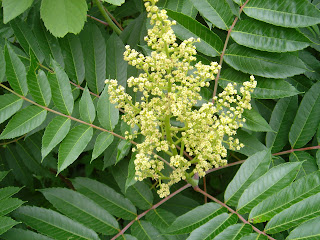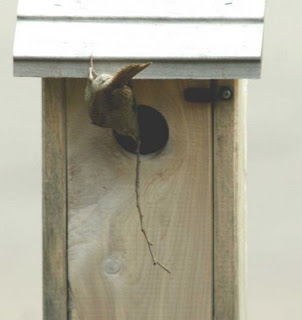We've seen toads of all sizes this year. But this one, shown in my hand at the base of my fingers, is the smallest so far.
8/02/2009
7/27/2009
bluebirds - brood 2, day 16
The young bluebirds fledged out of their nest today. We watched for hours as the adults fed them sparingly in the morning, then teased them with worms to encourage fledging. Inside, the three young flapped their wings, took turns perching at the opening, and called out for more food. The adults' response was most often a worm waved in front of the box (or offered but pulled back) to beckon the youngsters out.

7/25/2009
raspberries
The new row of raspberry brambles we put in last year are bearing fruit -- delicious red, black, and golden raspberries. The three are a wonderful mix of real intense berry flavor, but even better with a few of the little wild blackberries we find tucked in between the buckthorn and honeysuckle along the old fence row in the wild woods.

7/24/2009
hostas in bloom
The shady front corner is finally established with astilbes and hostas.
In past years I tried a few other plants here but they did not like the situation.
This Spring the astilbes and hostas came up vigorously and seem very happy together.
The "Krossa Regal" Hostas have become huge vase-shaped beauties with blooms on stems nearly as tall as I am.
In past years I tried a few other plants here but they did not like the situation.
This Spring the astilbes and hostas came up vigorously and seem very happy together.
The "Krossa Regal" Hostas have become huge vase-shaped beauties with blooms on stems nearly as tall as I am.
7/23/2009
bluebirds - winged lunch
The bluebird hatchlings are nearly as big as their parents, and showing off their feathers. The adults are now bringing larger and more interesting items for meals. Especially interesting on delivery are the delicious orthopterans, like this grasshopper, still kicking.
7/18/2009
7/17/2009
bluebirds - brood 2, day 7
Feeding time is ever amazing in the bluebird nest box. We were watching while the female was in the box with 4 hatchlings; the male brought a long worm to the entrance. The worm resisted the handoff, and the female bluebird had trouble grasping it. She left the box and the male brought the worm back in to feed his youngsters. It took him a few tries, but he did succeed. This would be a challenge for any marksman: stuff a writhing worm into the gape of a wobbly-headed baby bird. These parents are doing a good job -- all 4 hatchlings seem to be thriving.
7/12/2009
summer sumac
There is sumac growing outside my window that turns to burnished red and gold shades in the autumn. These shrubs seem to be leftovers from before the residential lots were here. Based on the property plat, they are growing along what was the old farm fence row. And, like sumac do, they strive each season to expand their position. I have enjoyed their brilliant autumn colors for a few years, but this summer is the first time I paid attention to them as they bloomed.
Another treat for us, compliments of our wild woods!

Another treat for us, compliments of our wild woods!
bluebirds - brood 2 hatched
The four bluebird eggs have become helpless little hatchlings. I watched today as the female brought some food, then the male brought in a many-legged item to feed them. She tried to convey it to the young but between their helpless writhing and the bug's wiggling legs, I'm not sure where it went. She did remove a "diaper bag", and he went back out to find something more suitable to feed those hungry beaks gaping in the nest.
7/06/2009
blooming on the edge
Coreopsis and scabiosa bloom happily together at the edge of the veggie garden.

7/03/2009
wren - second brood in snag box
In the wild woods we placed two PVC-tube nest boxes that simulate the tree snags which birds use for nesting sites. We packed sawdust in the tubes to make them seem like a decaying tree snag. Both have been totally excavated; earlier this season we watched a pair of black-capped chickadees remove all the sawdust from one tube before they built their nest inside. The other tube is excavated and has accumulated some nesting material but no active nest thus far. The tube that was the site of the successful chickadee nest is now the nest of a house wren. She laid her first egg today!
nest watching
This year, with video cams in several positions, we are able to verify much more bird nesting activity. We've watched as a pair of bluebirds fledged a brood of 5, chickadees fledged a brood of 6, and house wrens fledged a brood of 6. Last week we fed a stray baby robin several freshly-dig earthworms, then watched him sit in the maple tree the entire next day begging for more. Over the last several days we've watched as the bluebirds laid a new clutch of 4 eggs in their nestbox. The material in the snag box (formerly used by the chickadees) has been rearranged each day, and this morning one little wren egg is visible at the bottom of this deep cozy hideaway. I am still hoping to spot the nests of the cardinals, goldfinches, and hummingbirds that inhabit the wild woods.
6/29/2009
milkweed - scented delight
Weeding the vegetable garden today was a pleasure -- what a delightful hour. The sky was partly sunny with clouds floating by to cool me when the breeze was not enough. The soil was damp enough from recent rains so the weeds came out easily. And the milkweed that Julie started downhill from the veggie patch is in full scented bloom. The whiff of milkweed blooms on the breeze is, to me, the best -- sweet and spicy with hint of honey. And the blossoms are beautiful! No wonder the butterflies adore this plant. Monarchs, in particular, lay their eggs on the undersides of milkweed leaves and their caterpillars feed on them. 

6/25/2009
toad - good citizen in the wild woods
This 3" American toad Bufo Americanus was hopping around today while I was working in the garden.
There are plenty of frogs and toads like this in the yard, especially in the wet swale and the grassy quiet dark places. They are important in the food chain -- they help control many insect populations and they are food for other creatures. The DNR web site has good information about amphibian species in this area. http://www.dnr.state.mn.us/reptiles_amphibians/frogs_toads/toads/american.html

There are plenty of frogs and toads like this in the yard, especially in the wet swale and the grassy quiet dark places. They are important in the food chain -- they help control many insect populations and they are food for other creatures. The DNR web site has good information about amphibian species in this area. http://www.dnr.state.mn.us/reptiles_amphibians/frogs_toads/toads/american.html

6/20/2009
borage - improves tomatoes?
Last year, I learned that borage (Borago officinalis L.) is not only a pretty flowering edible herb, but it also improves the flavor of tomatoes when grown within a few feet of them. I did plant some borage seeds, and they blossomed profusely. I don't know if it helped my tomatoes, since weather and other variables seem to be in control here. And, this year, the volunteer borage is coming up throughout the veggie garden.


6/18/2009
sparrow spooker
House sparrows harrassed the bluebirds that were trying for a second brood in the bluebird box. We had tried a "sparrow spooker" with mylar dangles with some success. But the persistent sparrows got too aggressive. I installed a "monofilament line" spooker on the nestbox, and so far it has kept them away. Theoretically, the monofilament lines are arranged to prevent the ground-feeding sparrows from landing or perching on the roof or front entry area while bluebirds (aerial feeders) can easily navigate among the lines.
I found the instructions and information at
http://www.sialis.org/hosp.htm scroll down to "monofilament".
I found the instructions and information at
http://www.sialis.org/hosp.htm scroll down to "monofilament".
6/16/2009
chickadees - fledged
The first brave little Black-capped Chickadee (Poecile atricapilla) left the nest on Friday, day 17 after hatching. The other 5 launched themselves out of the nest on Saturday after much coaxing from the adults outside.
6/08/2009
tamarack - loaded with cones
6/07/2009
chickadees - 11 days old
Watching the 6 chickadee hatchlings on the video cam is addictive. Amazing how fast they are growing. Expect them to fledge out of the nest at day 15 or 16. In addition to this video cam in roof of the snag box, we're adding cameras outside to observe and record their fledging.
6/05/2009
bluebird - fledged first brood
We've been watching the bluebird nestbox for weeks as they brooded 5 eggs. The resulting 4 hatchlings are 17 days old. Today the parents coaxed the young birds, one at a time, to come out of the nestbox. Each in turn perched on the box opening with curiosity, watched and listened for danger, then flew bravely to the nearby maple tree.
Now we expect the adult pair to feed them for a few weeks while teaching them to hunt. Since bluebirds usually have two broods each season, we've outfitted the nestbox with a new improved camera.

Now we expect the adult pair to feed them for a few weeks while teaching them to hunt. Since bluebirds usually have two broods each season, we've outfitted the nestbox with a new improved camera.

6/01/2009
NestWatch
This year I am participating in NestWatch, a continent-wide nest-monitoring program that aims to provide a unified scheme to track reproductive success for all North American breeding birds. NestWatch teaches people about bird breeding biology and engages them in collecting and submitting nest records. NestWatch http://www.nestwatch.org/ is developed by the Cornell Lab of Ornithology in collaboration with the Smithsonian Migratory Bird Center, and funded by the National Science Foundation. Currently I am monitoring a bluebird nestbox, a house wren nest, a chickadee snag box, and searching for the nest sites of hummingbirds, cardinals, catbirds, and red-wing blackbirds that frequent the wild woods.
During November to April I participate in FeederWatch http://www.birds.cornell.edu/pfw/
During November to April I participate in FeederWatch http://www.birds.cornell.edu/pfw/
5/28/2009
5/25/2009
wren - twig nestbuilding
5/23/2009
chickadee - 8 eggs
We used the plans from NestWatch to emulate a "tree snag" nestbox using a PVC tube. A pair of chickadees found it quite cozy and built a nest inside. Monitoring the snag box for NestWatch, we noted on May 23 their clutch of 8 eggs.
5/02/2009
bluebird - first egg
This spring a pair of bluebirds (Sialia sialis) settled into the nestbox, and Bill’s camera system allowed me to get some amazing footage without disturbing the nest. Here the female is laying her first of 5 eggs.
Subscribe to:
Posts (Atom)

